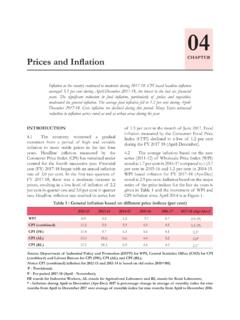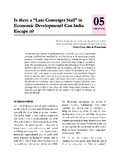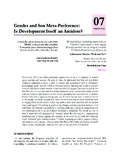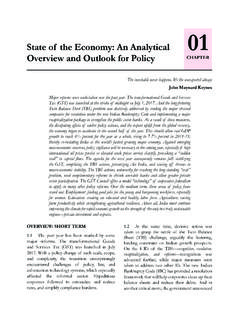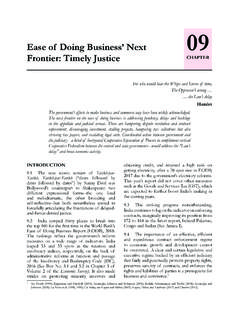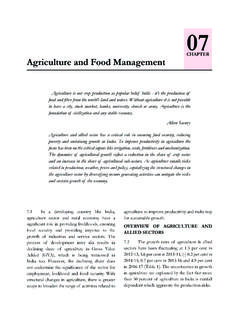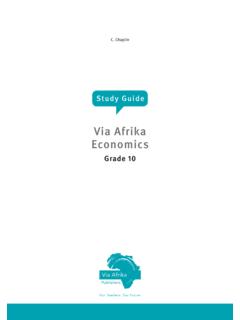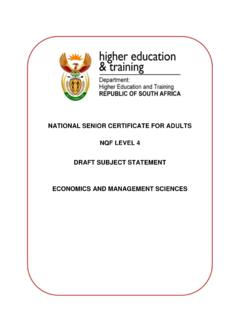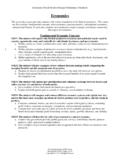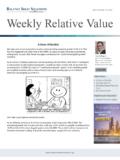Transcription of An Overview of India’s Economic - mofapp.nic.in:8080
1 An Overview of india 's Economic 01. CHAPTER. Performance in 2017-18. After registering GDP growth of over 7 per cent for the third year in succession in 2016-17, the Indian economy is headed for somewhat slower growth, estimated to be per cent in 2017- 18, as per first Advance Estimates released by CSO. This is slightly lower than the range of per cent to per cent being currently projected based on recent developments. Even with this lower growth for 2017-18, GDP growth has averaged per cent for the period from 2014-15 to 2017-18, which is the highest among the major economies of the world.
2 That this growth has been achieved in a milieu of lower inflation, improved current account balance and notable reduction in the fiscal deficit to GDP ratio makes it all the more creditable. In addition to the introduction of GST, the year also witnessed significant steps being undertaken towards resolution of problems associated with non-performing assets of the banks, further liberalization of FDI, etc., thus strengthening the momentum of reforms. After remaining in negative territory for a couple of years, growth of exports rebounded into positive one during 2016-17 and strengthened further in 2017-18.
3 There was an augmentation in the spot levels of foreign exchange reserves to close to US$ 414 billion, as on 12th January 2018. Concerns have been expressed about growing protectionist tendencies in some countries and it remains to be seen as to how the situation unfolds. Additionally, average crude oil (Indian basket) prices have risen by around 14 per cent so far in 2017-18 (mid January 2018) vis- -vis 2016-17. Going by the recent trends, the average crude oil prices could be in the vicinity of US$ 56-57 per barrel in the current financial year and could rise further by another 10- 15 per cent in 2018-19.
4 Some of these factors could have dampening effect on GDP growth in the coming year. However, with world growth likely to witness moderate improvement in 2018, expectation of greater stability in GST, likly recovery in investment levels, and ongoing structural reforms, among others, should be supporting higher growth. On balance, country's Economic performance should witness an improvement in 2018-19. GDP GROWTH IN 2017-18 4-year average to per cent, the broad story of india 's GDP growth to be significantly higher With Gross Domestic Product (GDP) than most economies of the world does not growth averaging per cent between 2014- alter.
5 The growth is around 4 percentage points 15 and 2016-17, india can be rated as among higher than global growth average of last 3 years the best performing economies in the world on and nearly 3 percentage points more than the this parameter. Although growth is expected to average growth achieved by emerging market &. decline to per cent in 2017-18, bringing the developing economies (EMDE) (Figure 1). 2 | Economic Survey 2017-18 Volume 2. Table : Key Indicators Data categories Unit 2014-15 2015-16 2016-17 2017-18.
6 GDP and Related Indicators GDP at constant market prices ` Crore 10536984 11381002 12189854PE 12985363AE. Growth Rate % GVA at constant basic prices ` Crore 9719023 10490514 11185440 PE. 11871321AE. Growth Rate % Gross Savings % of GDP na na Gross Capital Formation % of GDP na na Per Capita Net National Income (at current prices) ` 86454 94130 103219 111782. Production Food grains Million tonnes * #. Index of Industrial Productiona (growth) % Electricity Generation (growth) % Prices WPI Inflation (average) % change CPI (Combined) Inflation (average) % change External Sector Export Growth ( US$) % change Import Growth (US$) % change Current Account Balance (CAB)/GDP % Foreign Exchange Reserves US$ Billion Average Exchange Rate ` /US$ Money and Credit Broad Money (M3) (annual) % change Scheduled Commercial Bank Credit (growth) % change Fiscal Indicators (Centre).
7 Gross Fiscal Deficit % of GDP Revenue Deficit % of GDP Primary Deficit % of GDP Notes: na: Not Available PE : Provisional Estimates b : April-November 2017. AE : First Advance Estimates c : April-December 2017. BE : Budget Estimates d : April-September 2017. * : 4th Advance Estimates e : As on end 29th December 2017. # : 1st Advance Estimates, Kharif crops only f : As on 22nd December 2017. a : Base (2011-12=100) g : As on November 2017. An Overview of india 's Economic Performance in 2017-18 | 3. Figure 1 : Average growth of GDP respectively.
8 In 2017-18, service sector is expected during 2014-17 (per cent) to grow at per cent, as compared to per cent in 2016-17. Within the services sector, only the growth of Public administration, defence &. other services' sector is expected to decline in 2017-18 (Table 1). From a low of per cent in 2012-13, growth in GDP steadily improved for 3 years and peaked in 2015-16, particularly in fourth quarter World Advanced economies EMDE China india (Q4) when it printed per cent (GVA growth also peaked in Q4 of 2015-16).
9 However, growth Source: Based on IMF's World Economic Outlook Database (October 2017) started slowing down from first quarter (Q1) of 2016-17. GDP and GVA growth slowed to per As per the first Advance Estimates (1st cent and per cent respectively in Q4 of 2016- AE), released by Central Statistics Office (CSO), 17. GDP growth further declined to per cent growth rate of Gross Value of Added (GVA) at in Q1 of 2017-18. However, the second quarter constant basic prices is estimated at per cent in (Q2) of 2017-18 witnessed reversal of declining 2017-18, as compared to per cent in 2016-17.
10 Trend of GDP growth, with growth increasing to This is on account of lower growth in Agriculture per cent. The nominal GDP and GVA growth & allied', and Industry' sector, which are also picked up to per cent and per cent expected to grow at per cent and per cent respectively in Q2 of 2017-18 (Figure 2). Table 1 : Annual real GVA and GDP growth (per cent). GVA at basic prices from 2014-15 2015-16 2016-17 2017-18 (1st AE). Agriculture, forestry & fishing Industry Mining & quarrying Manufacturing Electricity, gas, water supply & other utility services Construction Services Trade, Hotel, Transport, Storage, communication &.
